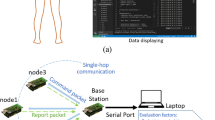Abstract
Body area networks (BAN) offer amazing perspectives to instrument and support humans in many aspects of their life. Among all possible applications, this paper focuses on body monitoring applications having a body equipped with a set of sensors transmitting in real time their measures to a common sink. In this context, at the application level, the network fits with a star topology, which is quite usual in the broad scope of wireless networks. Unfortunately, the structure of the network at the physical layer is totally different. Indeed, due to the specificity of BAN radio channel features, all radio links are not stationary and all sensors suffer from link losses during independent time frames. In wireless networks, link losses are often coped with multi-hop transmission schemes to ensure a good connectivity. However, since the radio links are not stationary, the multi-hop routes should adapt quickly to BAN changes. We instead propose in this work a different approach based on opportunistic relaying. The concept relies on electing some sensors to support the transmission of other ones having a worst connection. Instead of changing the relay time to time, we rather select a relay node from a statistical perspective. We evaluate this approach from a theoretical point of view and on realistic simulations using the packet error rate outage probability as a performance criterion.

















Similar content being viewed by others
References
D’Errico R, Ouvry L (2009) Time-variant ban channel characterization. In: IEEE PIMRC 2009
Cotton SL, Scanlon WG (2006) A statistical analysis of indoor multipath fading for a narrowband wireless body area network. In: IEEE 17th international symposium on personal, indoor and mobile radio communications, 2006, pp 1–5
Fort A, Desset C, De Doncker P, Wambacq P, Van Biesen L (2006) An ultra-wideband body area propagation channel model-from statistics to implementation. IEEE Trans Microwave Theor Tech 54(4):1820–1826
Hall PS, Yang H, Nechayev YI, Alomalny A, Constantinou CC, Parini C, Kamarudin MR, Salim TZ, Hee DTM, Dubrovka R, Owadally AS, Wei S, Serra A, Nepa P, Gallo M, Bozzetti M (2007) Antennas and propagation for on-body communication systems. IEEE Antennas Propag Mag 49(3):41–58
Roblin Ch, D’Errico R, Gorce J-M, Laheurte J-M, Ouvry L (2009) Propagation channel models for bans: an overview. In: COST2100, 7th management meeting. Braunschweig, Germany, p 29
Ray KJ, Liu A, Sadek K, Su W, Kwasinski A (2008) Cooperative communications and networking. Cambridge University Press, Cambridge
Gorce J-M, Goursaud C, Savigny C, Villemaud G, d’Errico R, Dehmas F, Maman M, Ouvry L, Miscopein B, Schwoerer J (2009) Cooperation mechanisms in bans. In: COST2100, 8th management meeting. Valencia, Spain, p 24
Maman M, Dehmas F, D’Errico R, Ouvry L (2009) Evaluating a TDMA MAC for body area networks using a space–time dependent channel model. In: IEEE 20th international symposium on personal, indoor and mobile radio communications, 2009, pp 1–5
Gorce J-M, Goursaud C, Villemaud G, D’Errico R, Ouvry L (2009) Opportunistic relaying protocols for human monitoring in bans. In: IEEE 20th international symposium on personal, indoor and mobile radio communications, 2009, pp 1–5
IEEE P802 (2008) Channel model for body area network (BAN). IEEE P802.15-08-0780-07-0006
Zhen B, Kim M, Takada J-I, Kohno R (2009) Characterization and modeling of dynamic on-body propagation. In: 3rd international conference on pervasive computing technologies for healthcare, 2009. PervasiveHealth 2009, vol 1–3, pp 1–6
Einsmann C, Quirk M, Muzal B, Venkatramani B, Martin T, Jones M (2005) Modeling a wearable full-body motion capture system. In: Proceedings ninth IEEE international symposium on wearable computers, 2005, pp 144–151
Zhao Y, Hao Y, Alomainy A, Parini C (2006) UWB on-body radio channel modeling using ray theory and subband FDTD method. IEEE Trans Microwave Theor Tech 54(4):1827–1835
Cotton SL, Conway GA, Scanlon WG (2009) A time-domain approach to the analysis and modeling of on-body propagation characteristics using synchronized measurements at 2.45 GHz. IEEE Antennas Propag Mag 57(4):943–955
Maman M, Denis B, Pezzin M, Piaget B, Ouvry L (2008) Synergetic MAC and higher layers functionalities for UWB LDR-LT wireless networks. In: IEEE international conference on ultra-wideband, 2008. ICUWB 2008, vol 3, pp 101–104
IEEE 802.15.4 (2007) Wireless MAC and physical layer specifications for low rate wireless personal area networks. IEEE 802.15.4 Standard
Mary P, Dohler M, Gorce J-M, Villemaud G (2011) Symbol error outage analysis of MIMO OSTBC systems over Rice fading channels in shadowing environments. IEEE Trans Wirel Commun (in press)
Zhang R, Gorce J-M, Jaffrès-Runser K (2008) Energy-delay bounds analysis in wireless multi-hop networks with unreliable radio links. Technical report 6598, INRIA
Miorandi D, Altman E (2005) Coverage and connectivity of ad hoc networks presence of channel randomness. In: INFOCOM 2005. 24th annual joint conference of the IEEE computer and communications societies, vol 1, pp 491–502
Srivastava V, Neel J, Mackenzie AB, Menon R, Dasilva LA, Hicks JE, Reed JH, Gilles RP (2005) Using game theory to analyze wireless ad hoc networks. IEEE Commun Surv Tutor 7(4):46–56
Comaniciu C, Mandayam NB, Poor V (2009) Radio resource management for green wireless networks. In: Proc. of IEEE vehicular conference (VTC). Anchorage, Alaska, pp 1–5
Yan L, Hailes S (2008) Cooperative packet relaying model for wireless ad hoc networks. In: FOWANC ’08: proceeding of the 1st ACM international workshop on foundations of wireless ad hoc and sensor networking and computing. ACM, New York, pp 93–100
Zhang R, Gorce J-M, Jaffrès Runser K (2009) Low bound of energy-latency trade-off of opportunistic routing in multi-hop networks. In: Allemagne D (ed) IEEE international conference on communications (ICC). IEEE, Dresden
Acknowledgement
This work has been carried out with the support of the project BANET (“Body Area Networks and Technologies”) supported by the French National Research Agency (ANR).
Author information
Authors and Affiliations
Corresponding author
Rights and permissions
About this article
Cite this article
Ferrand, P., Maman, M., Goursaud, C. et al. Performance evaluation of direct and cooperative transmissions in body area networks. Ann. Telecommun. 66, 213–228 (2011). https://doi.org/10.1007/s12243-011-0238-y
Received:
Accepted:
Published:
Issue Date:
DOI: https://doi.org/10.1007/s12243-011-0238-y




